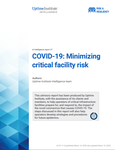As infection rates of Covid-19 increase, the virus has obvious implications for business continuity across the entire economy and data centers are no exception. The sector has a number of characteristics that should aid resilience such as high security with all movements to, from, and within facilities tracked; highly automated operations; a very strong focus on business continuity and risk management and low levels of human traffic.
This article explains why data centers matter and looks at the precautions operators are taking to ensure that sites continue to provide uninterrupted service to their customers. It also outlines the key challenges we are facing that we cannot tackle alone.
Why data centers matter
Data centers receive, process, manage, store and transmit digital data and are part of our core digital infrastructure. Every time we read a post on social media, order our shopping from a supermarket get directions for a journey, download a film, send an email or check the weather forecast, a data center is involved. In fact, a single transaction usually depends on many data centers interacting – not just one. Behind that, of course, it is data centers that enable supermarkets to resupply, retailers and banks to process financial payments and delivery companies to manage logistics, and government to deliver services. Data centers are the physical manifestation of our digital economy: we cannot lead connected lives without data centers.
The spread of Covid-19 means that the demand for digital communications, and therefore for the data center services that underpin them, is rising sharply. Europe’s largest internet exchanges have seen record traffic this week as more and more people move to remote working, teleconferencing (and possibly for those with time on their hands, some extra Netflix streaming).
As schools close, many pupils are already switching to remote learning through Google Classroom and similar tools. And, as social distancing bites, online shopping for food and other commodities is rocketing, with many supermarket delivery services at capacity. For people self-isolating, especially those living alone, tools like Skype and WhatsApp help keep them connected to friends and family. Internet communications, underpinned by data centers, also enable government to share the latest information and advice to individuals, especially those in isolation.
What are operators doing to ensure business continuity?
Although data centers are highly automated, they still need maintenance, management, security and servicing to ensure that the computer servers they house continue to work reliably. So, what are operators doing to ensure that Covid-19 does not compromise their ability to operate? Quite a lot, it appears.
- At sector level
techUK has been running weekly calls to share best practice and identify challenges. Operators have been comparing notes on how they are identifying and managing these Covid-19 risks and on the precautions they are putting in place. Competitors are working together to share information on procedures to limit infection, on quarantine, on decontamination routines, on HR and supply chain issues, on security of utility supplies and other operational matters. These calls will continue until they are no longer needed. - At operator level
The key priority is to balance staff safety with availability. So the emphasis is currently on limiting routes for infection whilst ensuring that facilities remain adequately staffed. Precautions reflect location and distribution of sites, the footfall to those sites, and individual site characteristics. All operators have implemented new guidelines and upgraded security controls. Intra-company communications have been stepped up with the usual reporting lines shortened or removed. Operators are working closely with suppliers and with customers to ensure that SLAs (service level agreements) continue to be met, to ensure that critical spares can be obtained and to explore potential scenarios. - At operational level
Data centers, especially those with multiple sites, were quick to implement precautions like shift segregation with no movement of personnel between shifts and no-contact handovers. Similarly, staff movement between sites has been restricted for some time, and within sites workloads are no longer shared between staff where possible. There has been a widespread ban on industry gatherings for operational staff and both foreign and domestic travel constraints have been in place for all staff for some time. Non-operational staff are largely working from home and the supply chain is under intense scrutiny. It goes without saying that standard measures like increased levels and frequency of cleaning, use of viricidal wipes, sanitization measures, changes to sign-in procedures and reduced person-to-person contact have all been applied across the board.
Looking further ahead, operators are already planning post-contamination cleaning procedures, irrespective of whether these will be needed. These accommodate current PHE guidance for non-clinical settings. Tracking will help to focus cleaning activity. Specialist services are being identified and provision for deep cleaning appropriate to data center environments is being planned.
Challenges facing the sector
We mentioned above that the key challenge for operators is to minimize routes for infection whilst keeping enough staff on site to manage facilities safely. However, operators are considering external challenges beyond their sphere of influence that they cannot address by themselves.
The first of these is access: ensuring that operational and key support staff will be able to get to site, especially in the event of a lockdown scenario. Although data centers underpin almost all our economic activity in one way or another, very few facilities are formally designated as CNI (Critical National Infrastructure). Operators urgently need an undertaking from Government that data center staff will be recognised as key workers and allowed access to their facilities - and prioritized for child care if needed. The sector is on hand to work with officials and policy makers to implement this in practice.
The second is energy: The reliability of utility supply is not an immediate concern for operators: all have emergency standby capacity and are equipped for outages. However, very long-term outages could put pressure on the gas and oil distribution network and this second-tier risk is being addressed by operators, although likelihood of such a scenario is considered to be low.
The third is supply chain: Operators are already ensuring that equipment coming from high risk areas is uncontaminated and are sourcing commissioning and installation staff from elsewhere. However, the complexity of the data center supply chain means that even equipment sourced from low risk areas contains components from high risk areas. Besides these short-term concerns there is the potential problem of longer-term shortages due to a slowdown or cessation of manufacturing output.




